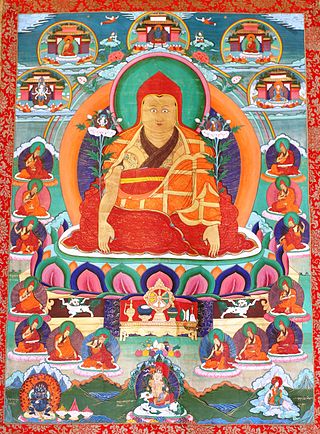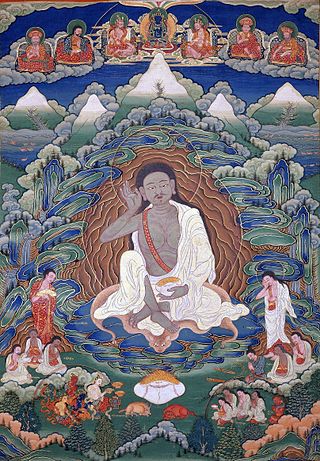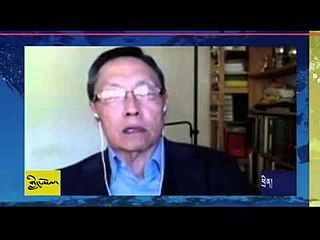
Bon or Bön, also known as Yungdrung Bon, is a Tibetan religious tradition with many similarities to Tibetan Buddhism and also many unique features. Bon initially developed in the tenth and eleventh centuries, but may retain elements from earlier religious traditions. Bon remains a significant minority religion in Tibet and in the surrounding Himalayan regions.

The Tibetan Buddhist canon is a loosely defined list of sacred texts recognized by various sects of Tibetan Buddhism. In addition to sutrayana texts from Early Buddhist schools and Mahayana sources, the Tibetan canon includes tantric texts. The Tibetan Canon underwent a final compilation in the 14th century by Buton Rinchen Drub (1290–1364).

The Jonang is one of the schools of Tibetan Buddhism. Its origins in Tibet can be traced to early 12th century master Yumo Mikyo Dorje, but became much wider known with the help of Dolpopa Sherab Gyaltsen, a monk originally trained in the Sakya school. The Jonang school’s main practice comes from the Kalachakra cycle.
Zhangzhung or Shangshung was an ancient kingdom in western and northwestern Tibet, which pre-dates the culture of Tibetan Buddhism in Tibet. Zhangzhung culture is associated with the Bon religion, which has influenced the philosophies and practices of Tibetan Buddhism. Zhangzhung people are mentioned frequently in ancient Tibetan texts as the original rulers of today's western Tibet. Only in the last two decades have archaeologists been given access to do archaeological work in the areas once ruled by the Zhangzhung.

The Tibetan Buddhist canon is a loosely defined collection of sacred texts recognized by various schools of Tibetan Buddhism, comprising the Kangyur or Kanjur and the Tengyur or Tanjur.
Tibetology refers to the study of things related to Tibet, including its history, religion, language, culture, politics and the collection of Tibetan articles of historical, cultural and religious significance. The last may mean a collection of Tibetan statues, shrines, Buddhist icons and holy scripts, Thangka embroideries, paintings and tapestries, jewellery, masks and other objects of fine Tibetan art and craftsmanship.
Zhang-Zhung is an extinct Sino-Tibetan language that was spoken in what is now western Tibet. It is attested in a bilingual text called A Cavern of Treasures and several shorter texts.

In Tibetan Buddhism and Bon, a ngagpa (male), or a ngagmo (female) is an ordained non-monastic practitioner of Dzogchen and Tantra. The ngagmapa are widely credited with protecting the Nyingma school and its teachings during the persecution of Buddhists in the reign of Langdarma.
Anne Carolyn Klein is professor of Religious Studies at Rice University in Houston, Texas and co-founding director and resident teacher at Dawn Mountain, a Tibetan temple, community center and research institute.
Rongzom Chökyi Zangpo, widely known as Rongzom Mahapandita, Rongzom Dharmabhadra, or simply as Rongzompa, was one of the most important scholars of the Nyingma school of Tibetan Buddhism. Together with Longchenpa and Ju Mipham, he is often considered to be one of the three "omniscient" writers of the school. His elder contemporary Atiśa (980–1054) considered Rongzompa to be an incarnation of the Indian ācārya Kṛṣṇapāda, the Great. The Tibetan historian Gö Lotsawa (1392–1481) said of Rongzom that no scholar in Tibet was his equal.

Françoise Pommaret is a French ethno-historian and Tibetologist. She holds the position of Director of Research at the Centre national de la recherche scientifique (CNRS). Her work focuses on Bhutan.
Charles Albert Edward Ramble is an anthropologist and former University Lecturer in Tibetan and Himalayan Studies at the Oriental Institute, Oxford University. Since 2009 he has been Professor and Directeur d'études at the Ecole pratique des hautes études, Paris. Between 2006 and 2013 he was elected president of the International Association for Tibetan Studies (IATS) and convened the 10th seminar of IATS at Oxford in 2003.
Per Kværne is a Norwegian tibetologist and historian of religion.

Drongtse Monastery is a Tibetan Buddhist monastery was formerly one of the most important Gelug monasteries in Tsang, Tibet. There was also a chorten there.

Françoise Robin is a Tibetan-studies professor at Paris' National Institute of Oriental Languages and Civilizations (INALCO), where she specialises in the language, cinema, and literature of Tibet. Robin is currently the general secretary of the International Association for Tibetan Studies.

Samten Gyeltsen Karmay (1936-) is a writer and researcher in the field of Tibetan Studies. His work is focused on the study of Tibetan myths, beliefs, the Bon religion and religious history.

Robert Barnett is a Professorial Research Associate at SOAS, University of London and Affliate Lecturer and Research Affiliate at the Lau China Institute, King's College, London. He is the former Director of the Modern Tibetan Studies Program, where he was Adjunct Professor of Contemporary Tibetan Studies and Senior Research Scholar in modern Tibetan history at the Weatherhead East Asian Institute at Columbia University. He retired from Columbia as of January 2018. He is also referred to as Robbie Barnett by the media.

David Francis Germano is an American Tibetologist and Professor of Tibetan and Buddhist Studies at the University of Virginia (UVa), the largest Tibetan Studies program in the Americas, where he has taught and researched since 1992. With dual appointments in the School of Nursing and the Department of Religious Studies, Germano currently oversees the work of over twenty graduate students. He is on the board of the International Association of Tibetan Studies and is Editor-in-Chief of The Journal of the International Association of Tibetan Studies (JIATS), a leading journal of Tibetology. In 2000, he founded the Tibetan and Himalayan Library, a digital initiative for collaborative building of knowledge on the region, which he continues to lead as Director. Since 2008 he has also been the co-director of the UVa Tibet Center. More recently, Germano acted as the founding director of SHANTI at the UVa. Since 2011, Germano has also played a leading role in organizing the University of Virginia's Contemplative Sciences Center, which he currently directs.
The Bodongpa or Bodong tradition, is one of the smaller traditions of Tibetan Buddhism falling outside the classification of the four main schools.
Janet Gyatso is a Religious Studies scholar currently employed as the Hershey Professor of Buddhist Studies and the Associate Dean for Faculty and Academic Affairs at Harvard Divinity School. She is a member of the American Academy of Arts and Sciences. Gyatso's research interests are in Buddhism and its relationship to Tibetan and South Asian civilizations.










